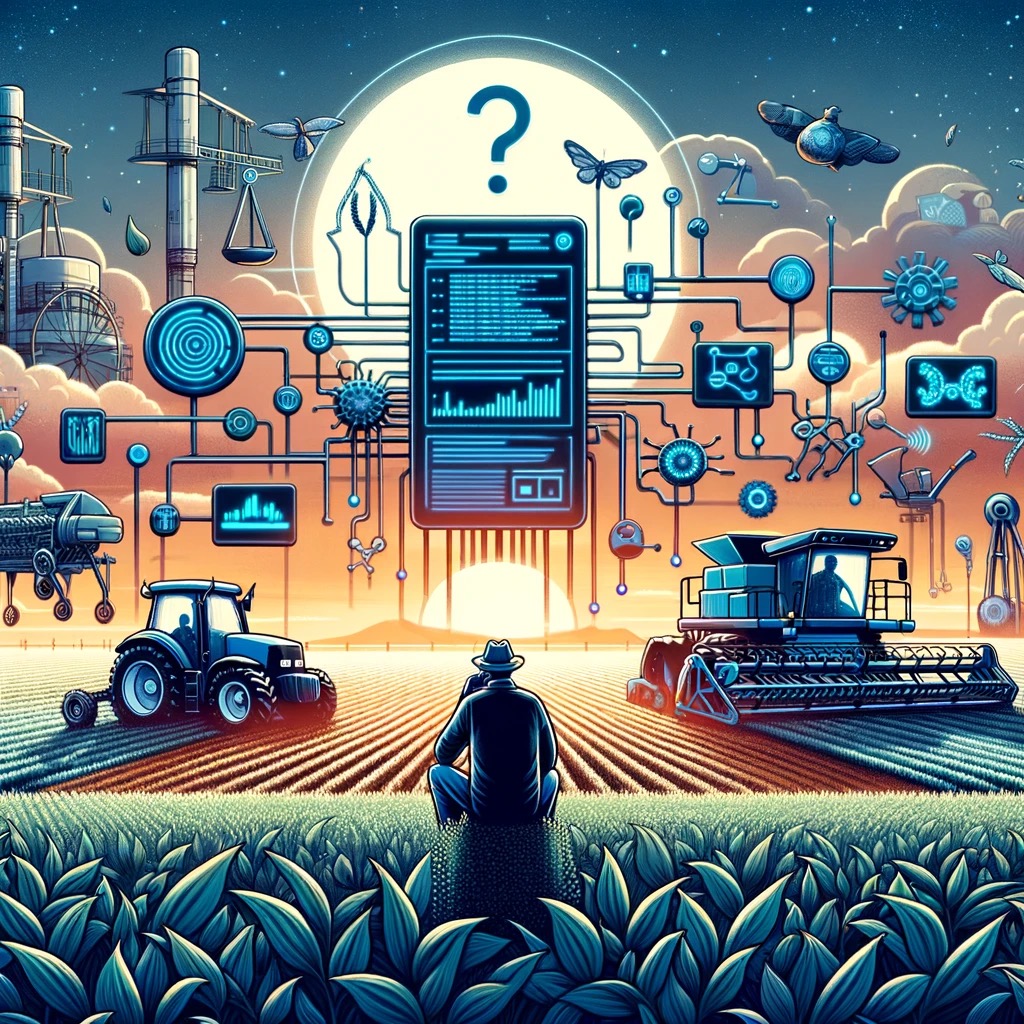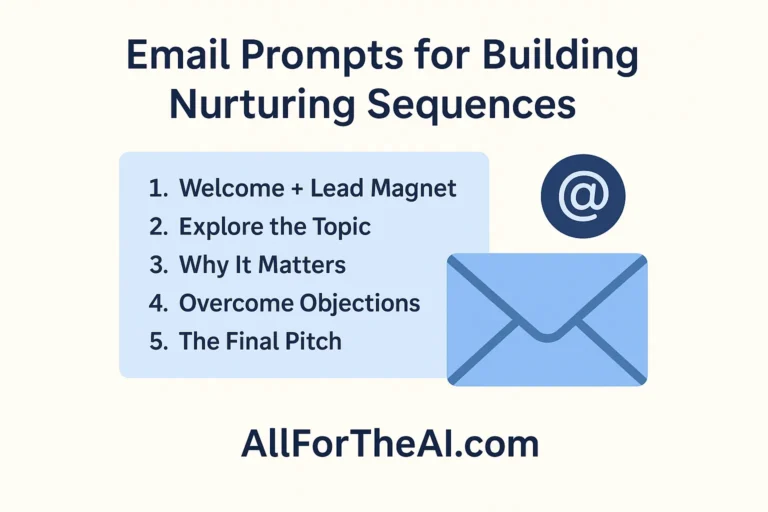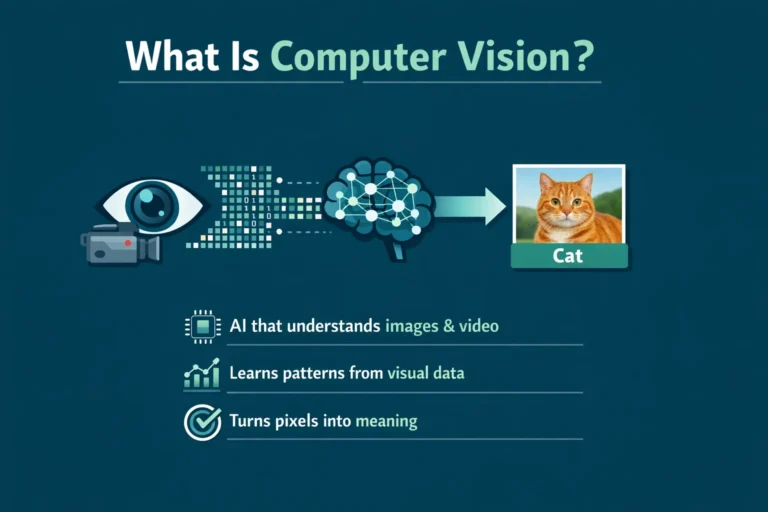AI in Agriculture: Harvesting the Future
AI in agriculture marks a pivotal shift in the landscape of farming practices, ushering in an era of precision agriculture and sustainable farming. This transformation is not just an incremental change but a fundamental reimagining of how food is produced, with AI at the heart of this revolution. By integrating AI technologies into agriculture, farmers, and agribusinesses are unlocking new potentials in crop management, yield optimization, and resource conservation, heralding a future where farming is more efficient, less resource-intensive, and more aligned with environmental sustainability.
1. AI’s Impact on Agriculture
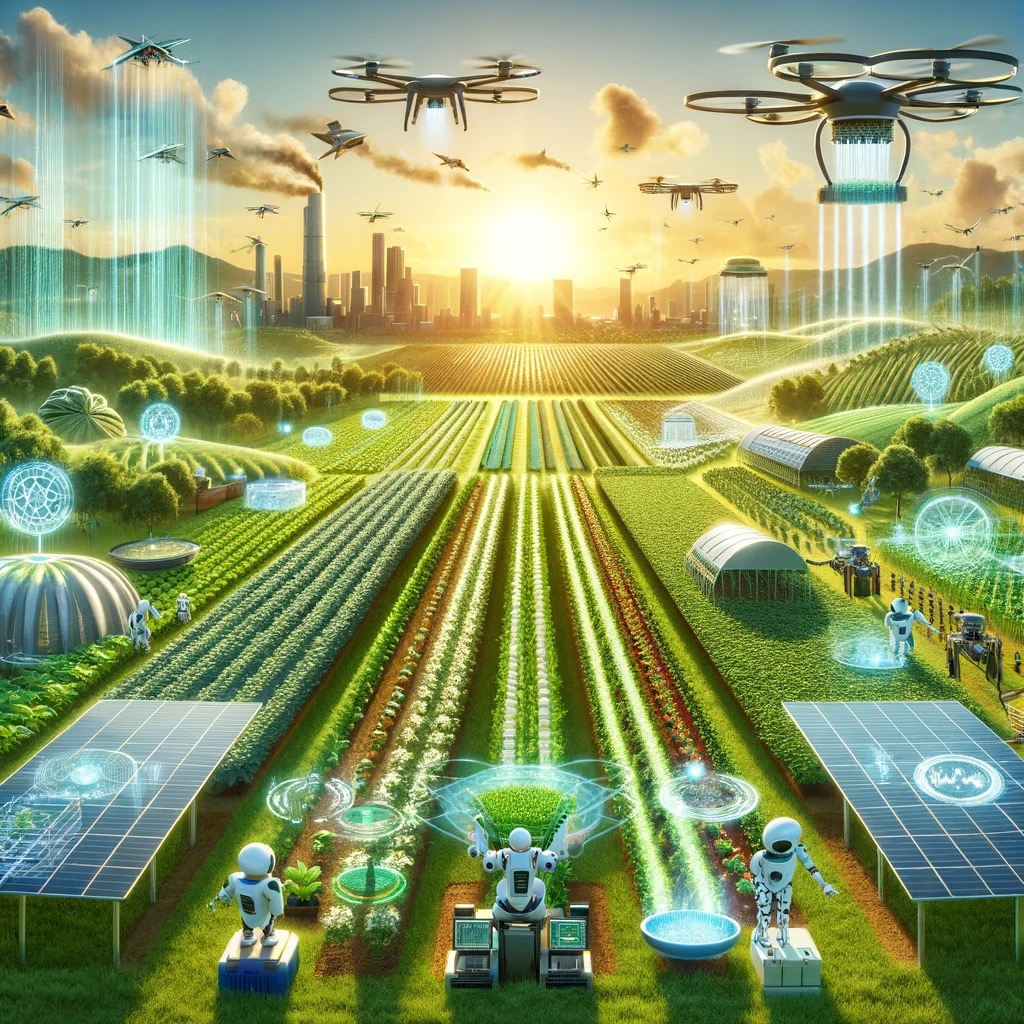
Overview of AI’s Impact on Agriculture
AI’s impact on agriculture is profound and multifaceted, touching every aspect of the farming lifecycle from seed selection to harvest.
Through advanced algorithms, data analytics, and machine learning models, AI enables the analysis of vast amounts of data from various sources, including satellite imagery, weather forecasts, soil sensors, and drone footage.
This data-driven approach facilitates informed decision-making, allowing for the precise application of water, fertilizers, and pesticides, reducing waste and environmental impact.
Furthermore, AI-powered systems can monitor crop health in real-time, predict agricultural outcomes, and automate labor-intensive tasks, making farming practices more efficient and productive.
The transformative role of AI in modern farming practices is most evident in its ability to adapt to and mitigate the challenges posed by climate change, resource scarcity, and the growing global population.
As traditional farming methods become increasingly unsustainable, AI is critical in ensuring food security and agricultural resilience.
By optimizing resource use and improving crop yields, AI addresses the immediate needs of the farm sector and contributes to the long-term sustainability of farming practices globally.
The Transformative Role of AI in Modern Farming Practices
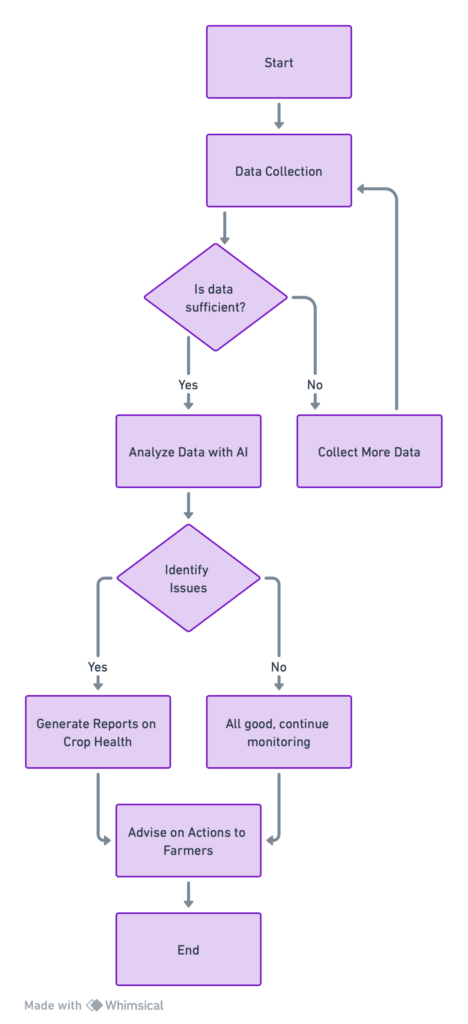
The application of AI in agriculture goes beyond mere technological innovation; it represents a paradigm shift in how we approach food production.
Precision agriculture, enabled by AI, allows for a level of granularity and control that was previously unimaginable.
Farmers can now monitor and manage the health of individual plants, tailor their practices to the specific needs of different crop varieties, and respond proactively to potential issues before they impact yield.
Moreover, AI-driven predictive analytics offer powerful insights into future agricultural trends, enabling farmers to make strategic decisions about crop rotation, planting schedules, and resource allocation.
These predictive models can forecast weather patterns, pest invasions, and crop diseases, providing farmers with a roadmap to navigate agriculture’s uncertainties more confidently.
The integration of AI in farming also extends to the automation of physical tasks through robotics.
From autonomous tractors that till the soil and plant seeds to drones that monitor crop health and robotic arms that pick fruit, AI-driven machines are redefining the boundaries of what is possible in agriculture.
This automation reduces the need for manual labor and increases precision and efficiency, freeing farmers to focus on strategic aspects of farm management.
The impact of AI on agriculture is a testament to the power of technology to transform industries and improve lives.
As we stand at the intersection of technological innovation and agricultural tradition, AI offers a pathway to a future where farming is more sustainable, efficient, and capable of meeting the global demand for food.
However, realizing this potential requires ongoing investment in AI research, the development of accessible technologies, and the adoption of best practices that prioritize environmental sustainability and equitable access to the benefits of AI.
As we embrace the transformative role of AI in agriculture, we must also navigate the ethical and practical challenges accompanying its integration, ensuring that the future of farming is as just as it is innovative.
2. Precision Agriculture and Crop Monitoring

Integrating Artificial Intelligence (AI) into agriculture has catalyzed a revolution in farming practices, marking the transition to precision agriculture and advanced crop monitoring.
These developments are not merely technological advancements but reshape the agricultural landscape, making farming more efficient, sustainable, and productive.
Precision agriculture leverages detailed data analysis to optimize farm management, from soil health to crop health monitoring, ensuring resources are used judiciously to maximize yield and minimize environmental impact.
Use of AI for Precision Agriculture
Precision agriculture represents a shift towards more data-driven, targeted farming practices.
At its core, AI enables the collection and analysis of vast amounts of data from diverse sources such as satellite images, soil sensors, weather stations, and IoT devices deployed in the field.
Machine learning algorithms process this data, identifying patterns and insights that human operators might not discern, enabling precise decision-making.
- Soil Health Monitoring: AI tools analyze data from soil sensors to assess moisture levels, nutrient content, and other soil health indicators. This information allows for tailored irrigation and fertilization strategies that optimize soil conditions for each crop, enhancing soil conservation and reducing water and nutrient waste.
- Crop Health Monitoring: By analyzing drone-captured imagery and satellite photos, AI algorithms can monitor crop growth, detect signs of stress, disease, or pest infestation, and evaluate the effectiveness of crop management strategies. This real-time monitoring facilitates swift interventions, maintaining crop health and minimizing potential yield losses.
Examples of AI-driven Crop Monitoring Technologies

The practical applications of AI in crop monitoring are diverse and innovative, offering tangible benefits to the agricultural sector:
- Drones Equipped with AI: Drones, equipped with high-resolution cameras and AI analysis tools, fly over fields, capturing detailed images that reveal variations in crop health, moisture levels, and pest presence. Combined with AI’s analytical capabilities, this aerial perspective provides a comprehensive overview of crop status, enabling targeted interventions.
- Satellite Imagery Analysis: AI algorithms analyze satellite images to track crop growth, assess the impact of environmental factors, and predict yield with remarkable accuracy. This global perspective ensures that even the most remote farms can benefit from advanced crop monitoring, bridging the gap between small-scale farmers and large agribusinesses.
- Automated Pest Detection Systems: These systems leverage AI to analyze images captured in the field to identify pest species and infestation levels. By detecting pests early, farmers can implement precise control measures, reducing the need for broad-spectrum pesticides and preserving the ecological balance within the farm ecosystem.
- Soil and Plant Health Sensors: IoT devices in the field collect data on soil moisture, pH levels, and plant health indicators such as leaf temperature and color. AI algorithms process this data to provide actionable insights, enabling farmers to adjust irrigation, fertilization, and other management practices in real-time.
The advent of AI-driven precision agriculture and crop monitoring technologies represents a significant leap forward in the quest for sustainable and efficient farming.
By harnessing the power of AI, farmers can make informed decisions that optimize resource use, protect the environment, and enhance crop yields.
These technologies improve the profitability and sustainability of farms and contribute to global food security by enabling the agricultural sector to meet the increasing demand for food in a changing climate.
As we continue to explore the potential of AI in agriculture, it is clear that precision agriculture and advanced crop monitoring will play a pivotal role in shaping the future of farming.
3. AI in Pest and Disease Detection
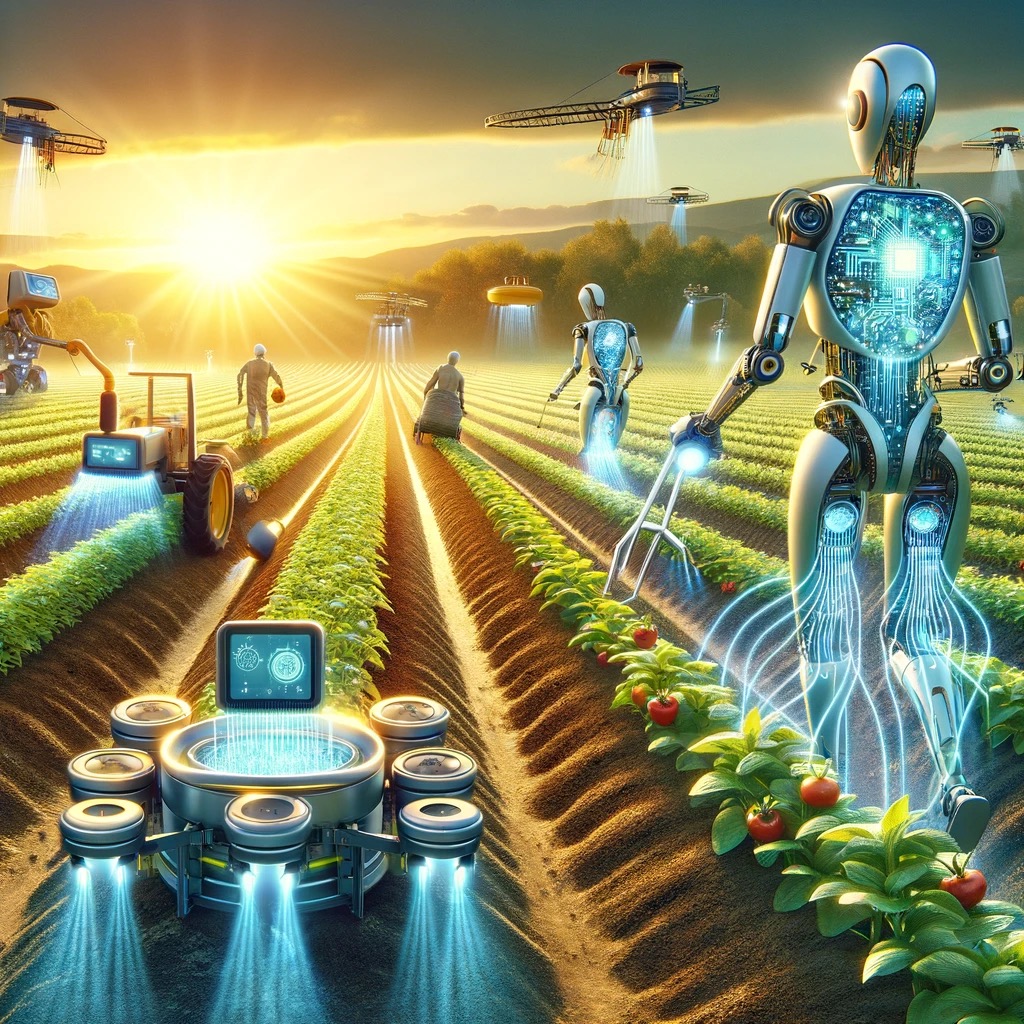
The application of Artificial Intelligence (AI) in pest and disease detection represents a significant advancement in agricultural practices, offering a proactive and precise approach to managing these perennial challenges.
By leveraging AI, farmers can detect and address pest and disease threats before they escalate, minimizing damage and reducing the reliance on chemical pesticides.
This section explores how AI facilitates the early detection and management of agricultural pests and diseases, supported by case studies highlighting the effectiveness of AI-driven solutions.
How AI Helps in Early Detection and Management of Pests and Diseases
AI-powered technologies enable the early detection of pests and diseases through sophisticated data analysis from various sources, including satellite imagery, drone photos, and field sensors.
Machine learning models, trained on vast datasets of agricultural images and patterns, can identify the subtle signs of pest infestations or disease outbreaks that might be invisible to the naked eye.
- Image Recognition for Pest Identification: AI algorithms analyze images captured by drones or field cameras to identify specific pest species based on visual markers. This precise identification allows for targeted interventions, reducing the need for broad-spectrum pesticide applications that can harm beneficial insects and the environment.
- Predictive Analytics for Disease Spread: AI models predict the spread of plant diseases by analyzing environmental conditions, historical outbreak data, and current crop health. These predictions enable farmers to implement preventative measures in vulnerable areas, potentially stopping an outbreak before it starts.
Case Studies Showcasing Effective AI Applications in Pest Control
- AI-Powered Drone Surveillance for Locust Detection: In response to locust swarms devastating crops across multiple continents, AI-driven drones have been deployed to detect and map locust activity. These drones, equipped with advanced imaging technology and AI analysis software, provide real-time data on swarm movements, allowing for timely and targeted control measures that minimize crop damage.
- Machine Learning Models for Early Blight Detection in Potatoes: A project utilizing AI to detect early signs of blight in potato crops demonstrated the potential for machine learning models to identify disease symptoms before they become apparent to farmers. By training the model on a dataset of potato leaf images, researchers achieved high accuracy in detecting early blight, enabling farmers to apply fungicides more judiciously and effectively.
- Automated Pest Detection Systems in Greenhouses: In controlled environments like greenhouses, AI-driven pest detection systems continuously monitor crop health through cameras and sensors. These systems can detect the early signs of pest infestation, such as aphids or spider mites, and alert farmers to apply localized treatments, preserving the overall health of the greenhouse ecosystem.
Integrating AI in pest and disease detection transforms agricultural pest management, shifting the paradigm from reactive to proactive measures.
By enabling early detection and precise identification, AI-driven technologies reduce the economic and environmental costs associated with pests and diseases.
These advancements contribute to increased crop yields, reduced chemical use, and support the broader goals of sustainable agriculture and food security.
As AI technology continues to evolve, its role in protecting crops from pests and diseases will undoubtedly expand, offering new tools and strategies for farmers worldwide to safeguard their harvests against these age-old adversaries.
4. AI-Driven Agricultural Robotics
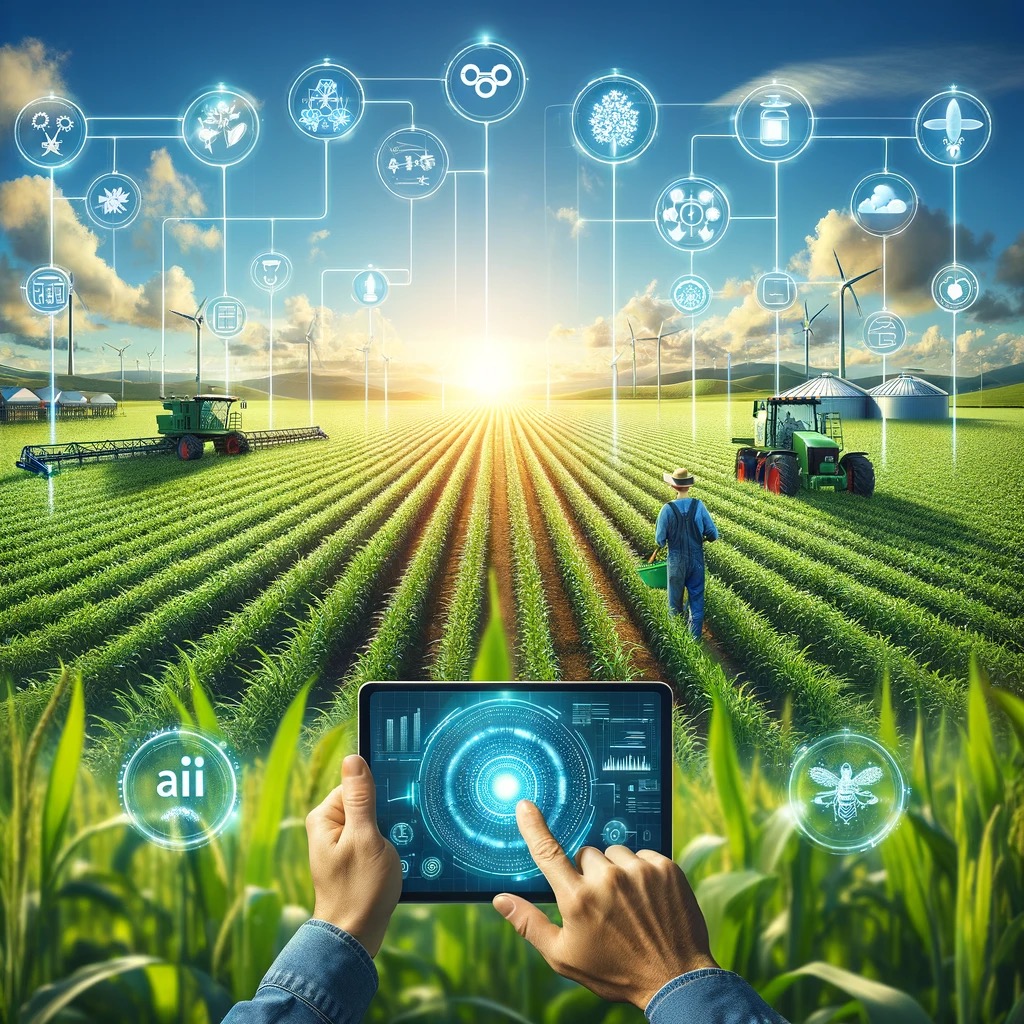
Integrating Artificial Intelligence (AI) with robotics in agriculture is paving the way for a new era of farming efficiency and precision.
AI-driven agricultural robots are revolutionizing traditional practices, performing tasks ranging from planting and weeding to harvesting with unparalleled accuracy and speed.
This transformative approach reduces the dependency on manual labor and enhances crop management and productivity.
The Role of Robots in Agriculture Powered by AI
AI-driven robots in agriculture are designed to perform a wide array of tasks, each contributing to various stages of the farming process:
- Planting: Robots equipped with AI algorithms can optimize planting patterns based on soil health data and environmental conditions, ensuring that seeds are sown in the ideal location and at the optimal depth for growth.
- Weeding: Leveraging AI, robots can distinguish between crops and weeds with high precision, allowing for targeted weeding that minimizes herbicide use and protects the crops.
- Harvesting: AI-powered robots can identify when fruits or vegetables are ripe for harvest, selecting and picking them with care to reduce waste and improve the quality of the produce.
These robots transform how tasks are performed on the farm, collect valuable data, further refine AI algorithms, and enhance farming practices over time.
Innovations and Advancements in Agricultural Robotics
The advancements in agricultural robotics highlight the innovative application of AI in farming:
- Autonomous Tractors: These tractors, guided by AI and GPS technology, can till, plant, and harvest without human intervention, operating around the clock to increase farm productivity. Their precision in navigating fields minimizes overlap and waste of resources, such as fuel and seeds.
- Drones for Precision Farming: AI-enhanced drones assess crop health from the air, applying pesticides and fertilizers only where needed. This targeted approach reduces the environmental impact of farming and lowers costs by minimizing the use of inputs.
- Robotic Harvesters: Robots equipped with AI vision systems can identify ripe fruits and vegetables, harvesting them with the same care as a human worker. These robots are particularly valuable in tasks requiring delicacy, such as picking soft fruits, which are prone to damage if not handled properly.
- Weed Control Robots: AI-driven robots targeting weeds offer an eco-friendly alternative to chemical herbicides. These robots significantly reduce the chemical load on fields by using mechanical methods or targeted applications of herbicides directly onto the weeds.
AI-driven agricultural robotics represents a significant leap forward in pursuing sustainable and efficient farming practices.
By automating routine tasks, these robots alleviate agriculture’s labor challenges and enhance crop management precision, leading to higher yields and reduced environmental impact.
As the technology continues to evolve, the potential for AI in agriculture expands, promising further innovations that could redefine the future of farming.
The adoption of AI-driven robots in agriculture underscores the sector’s move towards embracing technology to sustainably meet the growing global food demand.
5. AI in Farm Management and Predictive Analytics
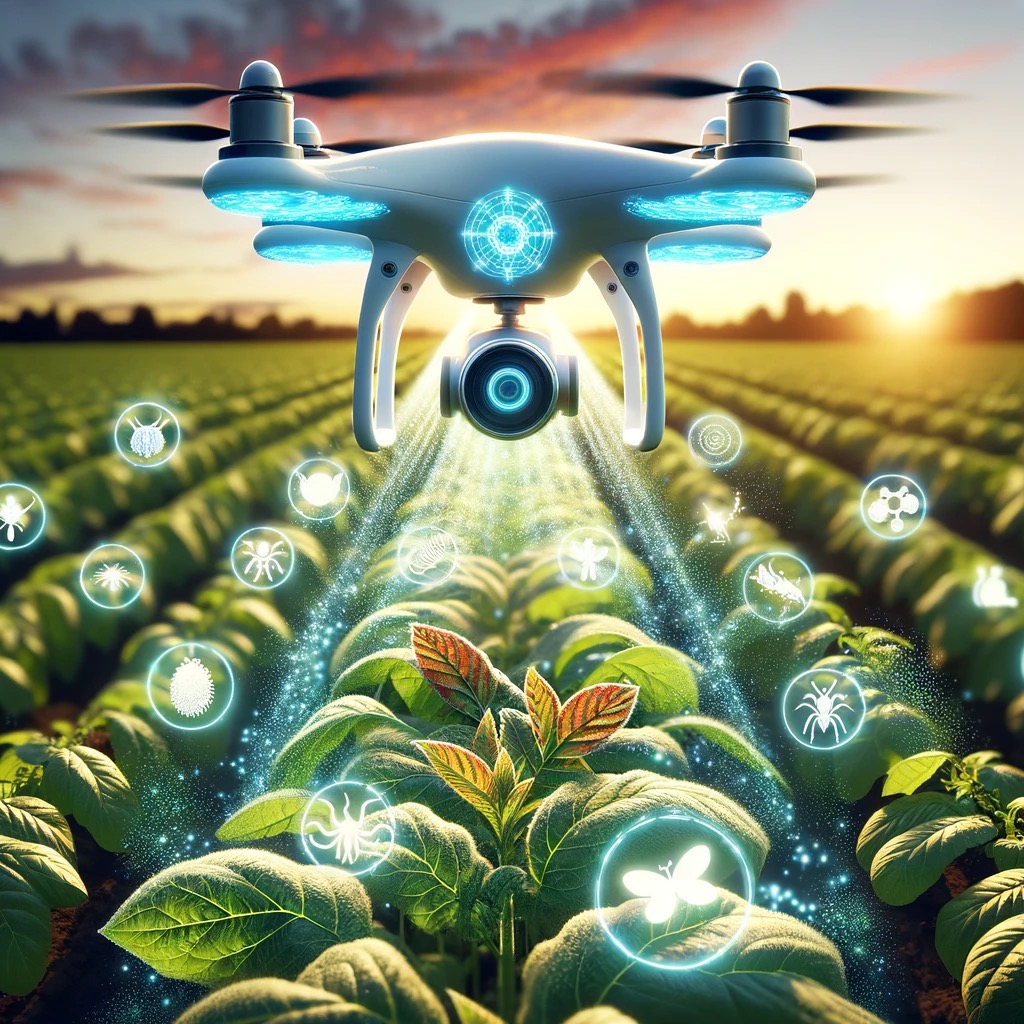
Incorporating Artificial Intelligence (AI) into farm management and predictive analytics redefines the agricultural industry’s cultivation, resource allocation, and yield optimization approach.
By leveraging AI, farmers can access insights that allow for more informed decision-making, improved efficiency, and increased crop yields.
This integration represents a significant shift towards data-driven agriculture, where predictive analytics can forecast future conditions and suggest optimal farming practices.
Utilization of AI for Farm Management Software
AI-powered farm management software synthesizes data from various sources—including satellite imagery, weather forecasts, soil sensors, and IoT devices in the field—to provide a comprehensive overview of farm operations.
This data-driven insight enables precision agriculture, where decisions on irrigation, planting, fertilization, and pest control are optimized to each crop and field’s specific needs.
- Resource Optimization: AI algorithms analyze soil health, weather patterns, and crop requirements to recommend precise amounts of water, fertilizers, and pesticides, thereby minimizing waste and reducing environmental impact.
- Yield Prediction: By processing historical yield data alongside current season analytics, AI models can accurately predict crop yields, aiding farmers in planning and marketing their produce more effectively.
Impact of AI on Decision-making in Farm Management
Integrating AI into farm management significantly enhances decision-making by providing accurate, timely, and actionable insights.
- Risk Management: Predictive analytics can forecast adverse weather conditions, pest outbreaks, or disease spread, allowing farmers to take preemptive actions to mitigate risks, such as adjusting planting dates or applying protective measures.
- Operational Efficiency: AI-driven tools automate routine tasks, such as irrigation scheduling and crop monitoring, freeing up time for farmers to focus on strategic aspects of farm management. This automation increases operational efficiency and contributes to labor cost savings.
- Market Insights: AI models can analyze market trends, demand forecasts, and price fluctuations, offering farmers guidance on the best times to sell their produce or which crops might be more profitable in future seasons.
Examples and Case Studies
- AI-based Irrigation Systems: These systems use AI to analyze weather data, soil moisture levels, and crop water requirements to optimize irrigation schedules, significantly reducing water usage while ensuring crops receive adequate hydration.
- Predictive Analytics for Disease Management: In California, grape growers have employed AI-driven platforms to predict the risk of powdery mildew, a common vineyard disease. The system analyzes weather data, vineyard microclimate, and historical disease incidence to forecast disease risk, allowing growers to apply fungicides only when necessary, reducing costs and environmental impact.
- Yield Forecasting Models: Companies are developing AI models that predict crop yields months before harvest by analyzing satellite images, weather data, and crop conditions. These predictions help farmers make informed decisions about resource allocation and market planning, enhancing profitability.
AI’s role in farm management and predictive analytics transforms agriculture into a more efficient, sustainable, and productive sector.
By harnessing the power of AI, farmers can optimize farm operations, anticipate future challenges, and make informed decisions that enhance yield and profitability.
As AI technologies evolve and become more accessible, their adoption in agriculture is set to increase, driving further innovations in farm management and contributing to global food security.
The future of farming lies in leveraging AI-driven insights to cultivate smarter, not harder, ensuring that agriculture can meet the demands of a growing global population while preserving the environment.
6. Challenges and Ethical Considerations in AI-driven Agriculture
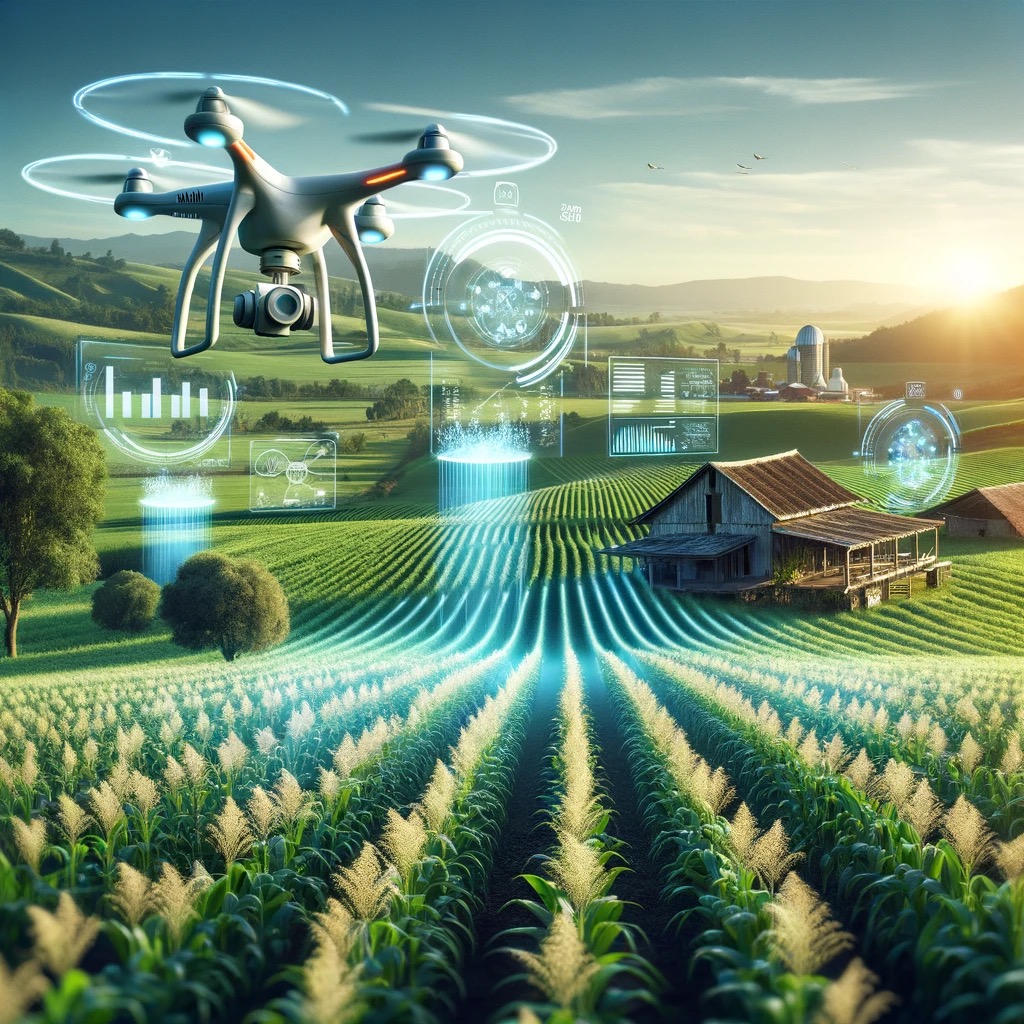
While offering transformative potential, integrating Artificial Intelligence (AI) into agriculture presents various challenges and ethical considerations.
These issues span the spectrum from technical and financial hurdles to broader societal impacts, including the digital divide and ethical use of technology.
Addressing these challenges is crucial for ensuring that the benefits of AI-driven agriculture are realized equitably and sustainably.
Addressing the Challenges of Implementing AI in Agriculture
- Cost and Accessibility: The high cost of AI technologies and the required infrastructure can be prohibitive for small-scale farmers and those in developing countries, exacerbating inequalities within the agricultural sector. Bridging this gap requires innovative financing models, subsidies, and support from governments and international organizations.
- Technical Expertise: Implementing and managing AI systems necessitates specific technical expertise, which may only be available in some farming communities. Training programs and accessible technical support are essential for broadening the adoption of AI in agriculture.
- Data Privacy and Security: As with any technology that relies on data, there are significant concerns about the privacy and security of the information collected by AI systems. Farmers must have assurances that their data is protected and that they retain ownership and control over its use.
- Reliability and Adaptability: AI systems are only as good as the data they are trained on and may only sometimes account for the unpredictable variables in agriculture, such as extreme weather events. Ensuring these systems are robust and adaptable to changing conditions is challenging.
Ethical Considerations in AI-driven Agricultural Practices
- Bias and Fairness: There is a risk that AI algorithms may inherit biases present in their training data, leading to unfair outcomes. For instance, if predictive models are primarily trained on data from large-scale farms, they may not perform as well for smallholders or underrepresented regions, further marginalizing these groups.
- Transparency and Accountability: AI systems’ decision-making processes can be opaque, making it difficult to ascertain how conclusions are reached. This lack of transparency can challenge accountability, particularly if AI-driven decisions negatively impact the environment or livelihoods.
- Socio-economic Impacts: AI-driven automation in agriculture could lead to job displacement, affecting rural economies. While it can increase efficiency, the social implications of reduced employment opportunities in farming communities must be carefully managed.
- Environmental Sustainability: While AI has the potential to enhance sustainability in agriculture, its implementation must be guided by ecological ethics. This includes ensuring AI-driven practices do not overexploit natural resources or harm ecosystems.
Strategies for Overcoming Challenges and Ensuring Ethical AI Use
Developing and implementing strategies to address these challenges and ethical considerations is essential for the sustainable advancement of AI in agriculture:
- Inclusive Development and Deployment: Involving a diverse group of stakeholders, including small-scale farmers, in the development and deployment of AI technologies can help ensure that these systems are accessible, equitable, and beneficial to all segments of the agricultural community.
- Ethical Guidelines and Standards: Establishing ethical guidelines and standards for the development and use of AI in agriculture can help mitigate biases, ensure transparency, and promote accountability.
- Education and Capacity Building: Investing in education and capacity building can equip farmers with the skills to implement and benefit from AI technologies, reducing the knowledge gap and fostering technological resilience.
- Sustainable Practices and Policies: Encouraging the adoption of AI applications that prioritize environmental sustainability and responsible resource use can help ensure that AI’s benefits in agriculture contribute to long-term ecological health.
Integrating AI into agriculture promises significant benefits, from increased efficiency and productivity to enhanced sustainability.
However, realizing these benefits requires careful attention to the challenges and ethical considerations accompanying AI technology deployment.
By addressing issues of cost, accessibility, technical expertise, and data privacy and ensuring that AI-driven agricultural practices are equitable, transparent, and environmentally sustainable, we can harness the full potential of AI to revolutionize farming in a way that benefits all stakeholders and the planet.
7. The Future of AI in Agriculture
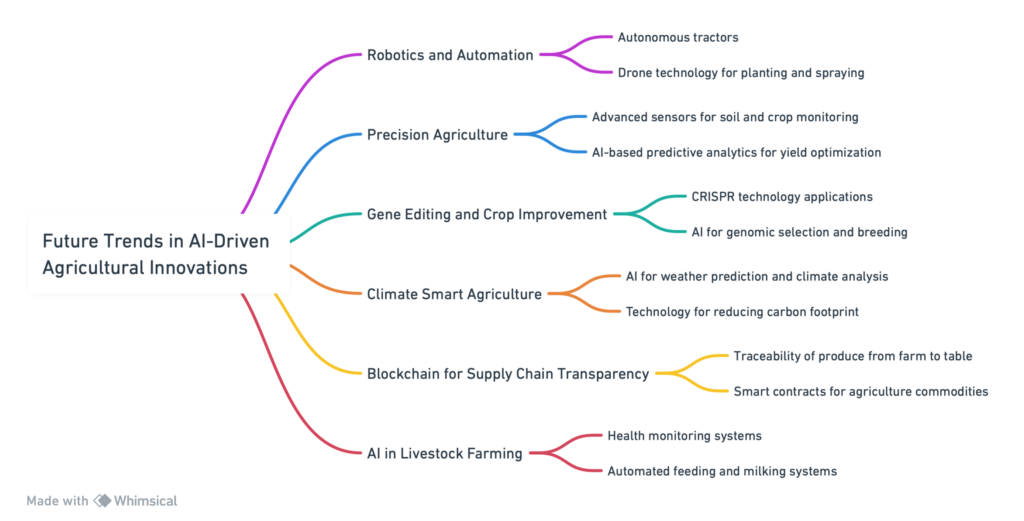
The future of Artificial Intelligence (AI) in agriculture is poised at the intersection of technology and sustainability. It promises to redefine food production, resource management, and environmental stewardship paradigms.
As AI technologies evolve and mature, they are expected to drive unprecedented advancements in agricultural practices, making farming more precise, efficient, and sustainable.
Emerging Trends and Future Directions for AI in Agriculture
- Integration of AI with Genomic Selection: AI’s potential to analyze complex genetic data could revolutionize crop breeding, enabling the development of crop varieties with enhanced yield, nutritional value, and resilience to climate change. By predicting the performance of crop genotypes in various environments, AI can significantly accelerate the breeding process, contributing to food security.
- Advanced Robotics for Autonomous Farming: The future will see more sophisticated agricultural robots powered by AI capable of performing a more comprehensive range of tasks with greater autonomy. These robots will plant, weed, harvest, and perform soil restoration, pest management, and crop rotation, operating seamlessly alongside human workers.
- AI-driven Precision Livestock Farming: AI technologies will extend more comprehensively into livestock management, precisely monitoring animal health and welfare. Wearable sensors and AI algorithms will provide real-time data on livestock, enabling interventions that improve health outcomes and productivity.
- Sustainable Resource Management: AI will play a critical role in optimizing the use of water, fertilizers, and energy, promoting sustainable farming practices that minimize environmental impact. By matching resource application to crop needs, AI can reduce waste and ensure that agriculture contributes positively to ecological conservation.
- Blockchain and AI for Supply Chain Transparency: Integrating AI with blockchain technology promises to enhance transparency and traceability in the agricultural supply chain. This combination will enable consumers to trace their food’s journey from farm to table while also providing farmers with valuable insights into market demand and supply chain efficiencies.
Predictions for How AI Will Continue to Revolutionize Farming Practices
- Data-Driven Agricultural Ecosystems: The future of agriculture will be increasingly data-driven, with AI at the core of decision-making processes. Farms will become interconnected ecosystems of data and technology, where every aspect of the environment and crop growth is monitored and managed through AI-driven insights.
- Customized Farming Solutions: AI will enable the development of customized farming solutions tailored to each farm’s specific needs, considering local environmental conditions, crop types, and sustainability goals. This personalized approach will maximize productivity and environmental benefits on a per-farm basis.
- Increased Collaboration Between Tech and Agri-sectors: The continued evolution of AI in agriculture will foster greater collaboration between the technology and agricultural sectors, leading to innovative solutions that address the complex challenges of modern farming. This collaboration will accelerate the adoption of AI technologies in agriculture, bridging the gap between cutting-edge research and practical farming applications.
The future of AI in agriculture holds immense promise, offering innovative solutions to enhance food production, improve resource efficiency, and address environmental challenges.
As we look forward to these advancements, it is crucial to approach the integration of AI in agriculture with a commitment to sustainability, equity, and inclusivity.
By doing so, we can ensure that the benefits of AI-driven technologies are realized broadly, contributing to global food security and the well-being of farming communities worldwide.
The journey ahead for AI in agriculture is not just about technological innovation but also about shaping a sustainable and equitable future for food production on a global scale.
8. Conclusion: AI’s Potential to Enhance Sustainability and Efficiency in Agriculture
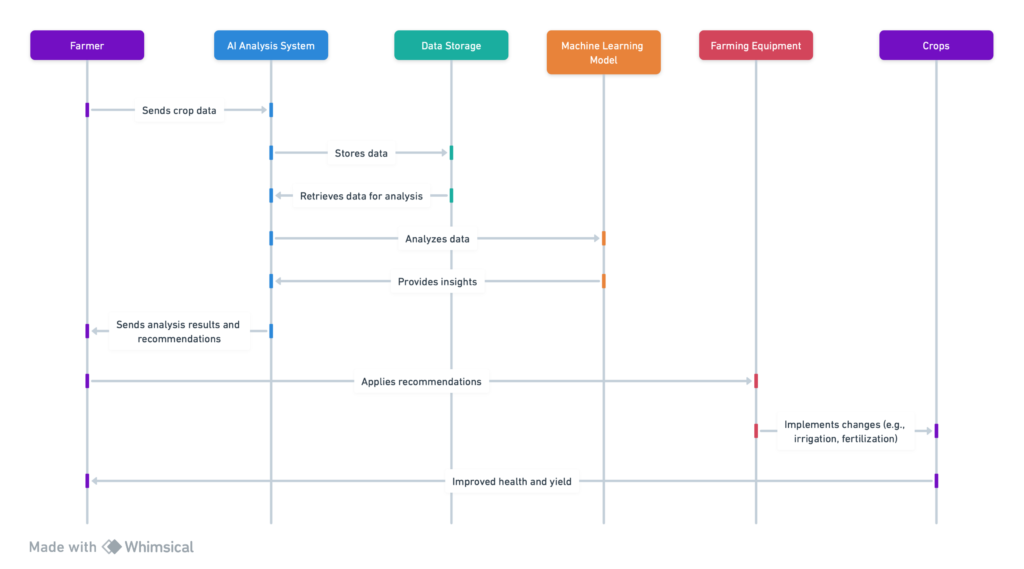
The exploration of Artificial Intelligence (AI) within agriculture unfolds a narrative of transformation and promise, highlighting a path toward more sustainable, efficient, and productive farming practices.
As we have journeyed through the various facets of AI’s integration into agriculture—from precision farming and crop monitoring to pest detection, agricultural robotics, and beyond—it becomes evident that AI is not merely a tool but a catalyst for redefining the essence of modern agriculture.
AI stands at the forefront of agricultural innovation, offering solutions that enhance crop yields, reduce environmental impact, and optimize resource use.
Through precise data analysis, predictive analytics, and autonomous operations, AI-driven technologies empower farmers to make informed decisions tailored to the intricate dynamics of their environments and crop needs.
This precision in agriculture boosts productivity and champions sustainability principles, ensuring that every drop of water, a particle of fertilizer, and an ounce of effort contributes to the maximal output with minimal waste.
The potential of AI extends beyond operational efficiencies to encompass the broader goals of environmental stewardship and global food security.
AI mitigates the agricultural sector’s ecological footprint by enabling more targeted resource use, preserving biodiversity, and reducing greenhouse gas emissions.
Furthermore, AI’s capabilities in yield prediction and disease detection play a pivotal role in ensuring food security, providing a buffer against the uncertainties of climate change and population growth.
However, realizing AI’s full potential in agriculture necessitates a balanced approach that addresses the challenges and ethical considerations inherent in technological adoption.
Issues of accessibility, data privacy, and the digital divide underscore the need for inclusive strategies that ensure the benefits of AI reach all corners of the agricultural community, from smallholder farmers in developing nations to large-scale agribusinesses.
Moreover, the ethical deployment of AI technologies must be guided by principles prioritizing sustainability, equity, and the well-being of human and ecological communities.
As we look to the future, the continued evolution of AI in agriculture holds the promise of further innovations that will not only refine existing practices but also open new avenues for sustainable farming.
The integration of AI with emerging technologies like blockchain for supply chain transparency and genomic selection for crop improvement exemplifies the dynamic potential of AI to foster advancements that resonate with both the immediate needs and long-term aspirations of the agricultural sector.
In conclusion, integrating AI into agriculture is marked by challenges and opportunities. It is a journey that demands collaborative efforts, innovative thinking, and a steadfast commitment to sustainability.
Encouraging AI’s responsible and ethical use in farming practices is an investment in technology and a pledge towards a future where agriculture harmonizes with nature, ensuring food security and environmental health for future generations.
As we embrace this future, AI stands as a beacon of hope, guiding the way toward a more sustainable, efficient, and equitable world of agriculture.
FAQ & Answers
1. How is AI used in agriculture?
AI is used in precision agriculture, pest and disease detection, agricultural robotics, and farm management, improving efficiency, sustainability, and crop yields.
2. What are the challenges of implementing AI in agriculture?
Challenges include high costs, the need for technical expertise, and ensuring technology is accessible to farmers of all sizes.
Quizzes
Quiz 1: “AI in Agriculture” – Match AI technologies to their agricultural applications.
For this quiz, I’ll list several AI technologies and their applications in agriculture. Your task is to match each technology to its correct application:
AI Technologies:
A. Machine Learning Models
B. Computer Vision
C. Drone Technology
D. Natural Language Processing (NLP)
E. Robotics and Automation
Agricultural Applications:
- Monitoring crop health and soil conditions across vast fields.
- Harvesting crops with minimal damage and maximum efficiency.
- Analyzing agricultural data to predict crop yields.
- Interpreting and responding to farmers’ queries in multiple languages.
- Identifying pests and diseases on crops through image analysis.
Match each AI technology (A-E) with its corresponding agricultural application (1-5).
Here are the matches between the AI technologies and their applications in agriculture:
A. Machine Learning Models – 3. Analyzing agricultural data to predict crop yields.
Machine learning algorithms can process vast amounts of data on weather conditions, soil quality, and crop health to accurately predict yields, helping farmers make informed decisions.
B. Computer Vision – 5. Identifying pests and diseases on crops through image analysis.
Computer vision technology analyzes images of crops to detect signs of pests and diseases early, allowing for timely intervention and reducing crop loss.
C. Drone Technology – 1. Monitoring crop health and soil conditions across vast fields.
Drones equipped with sensors and cameras can cover large areas quickly, providing detailed insights into crop health, soil moisture, and other critical factors for crop management.
D. Natural Language Processing (NLP) – 4. Interpreting and responding to farmers’ queries in multiple languages.
NLP enables agricultural chatbots and assistants to understand and respond to farmers’ questions and concerns in natural language, making access to information easier and more efficient.
E. Robotics and Automation – 2. Harvesting crops with minimal damage and maximum efficiency.
Robotic systems can be programmed to perform delicate tasks like picking fruits or harvesting crops, reducing waste and improving efficiency in the agricultural process.
These matches highlight how different AI technologies are being utilized to enhance various aspects of agricultural production, from improving crop management and yield prediction to automating labor-intensive tasks and providing timely assistance to farmers.
Quiz 2: “Innovations in Farming” – A quiz on recent AI breakthroughs in agriculture.
Let’s dive into some recent AI breakthroughs that are transforming agriculture. For each description, try to identify the specific innovation or the type of AI technology being discussed:
- Autonomous Weed Control Robots: These robots use AI to navigate through fields, identify weeds among crops using image recognition, and precisely remove or treat them without harming the crops. This innovation reduces the need for chemical herbicides and manual labor.
- AI-Powered Crop Disease Prediction Platforms: This platform leverages machine learning algorithms to analyze data from various sources, including satellite images and sensor data, to predict the outbreak of crop diseases before they occur, enabling farmers to take preventive measures in advance.
- Smart Irrigation Systems: Utilizing AI, these systems analyze weather forecasts, soil moisture levels, and crop water requirements to optimize irrigation schedules, reducing water usage while ensuring crops receive the precise amount of water they need.
- AI-Driven Livestock Monitoring Solutions: These solutions employ AI to monitor the health and behavior of livestock using cameras and wearable sensors. The system alerts farmers to any signs of illness, distress, or unusual behavior, improving animal welfare and farm productivity.
- Hyperlocal Weather Prediction Models: AI algorithms process data from local weather stations, satellites, and other sensors to provide highly accurate, farm-specific weather forecasts. This allows farmers to make better-informed decisions about planting, harvesting, and applying treatments.
Identify the specific innovation or the type of AI technology being described in these recent agricultural breakthroughs.
Here are the specific AI innovations or technologies being described in the recent agricultural breakthroughs:
- Autonomous Weed Control Robots: This innovation refers to AI-driven Precision Weed Removal technology. The robots, equipped with computer vision and AI, identify and precisely target weeds among crops, significantly reducing the reliance on chemical herbicides and manual labor.
- AI-Powered Crop Disease Prediction Platforms: The technology is Machine Learning for Predictive Analytics in Crop Health. By analyzing diverse data sets, including satellite imagery and environmental sensors, this platform predicts potential disease outbreaks, allowing for preemptive action to protect crops.
- Smart Irrigation Systems: This describes AI-Optimized Irrigation Management systems. Utilizing AI to analyze data on weather, soil moisture, and crop needs, these systems automate irrigation scheduling to use water more efficiently and support sustainable farming practices.
- AI-Driven Livestock Monitoring Solutions: The innovation is AI in Animal Health and Behavior Monitoring. Using data from cameras and wearable sensors, AI algorithms detect health issues and monitor the well-being of livestock, enhancing farm management and animal welfare.
- Hyperlocal Weather Prediction Models: This refers to AI-Enhanced Hyperlocal Weather Forecasting. By processing data from a variety of sources, AI generates accurate, farm-specific weather predictions, aiding farmers in making timely decisions related to crop management and operations.
Each of these AI breakthroughs showcases the potential of artificial intelligence to revolutionize traditional farming practices, leading to more efficient, sustainable, and productive agricultural systems.

